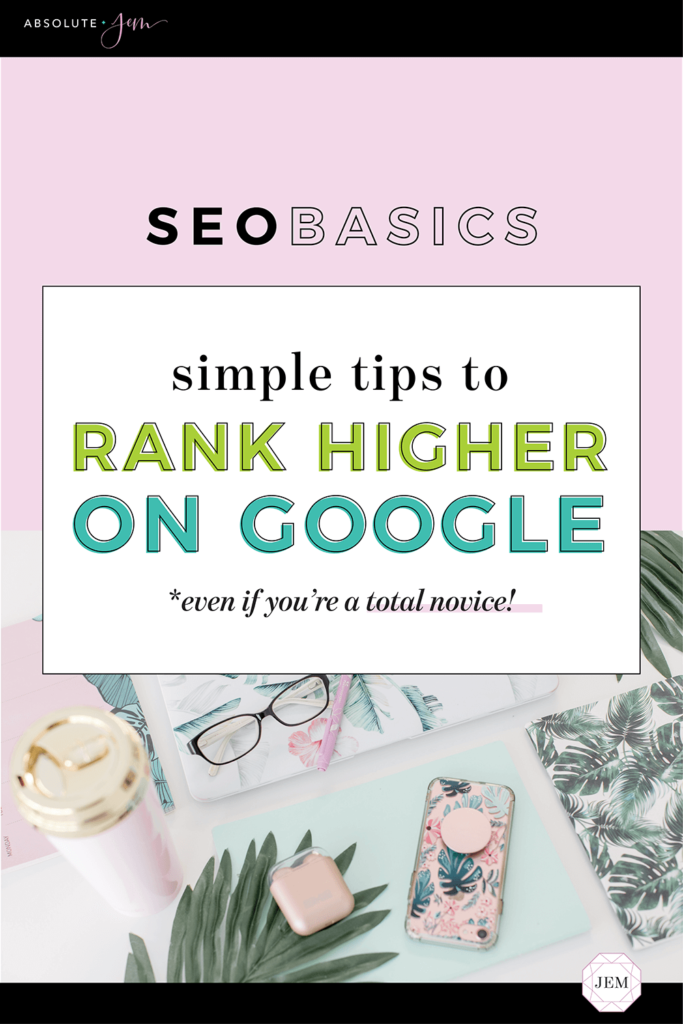Ranking on Google doesn't have to be an enigma wrapped in a riddle and cash.
(If you watch Bravo this makes sense.)
Before we begin, it's important to note that Google's main function is to deliver the most relevant and useful content to its users. So it's looking to best answer people's queries—first and foremost. And while that sounds all fine and dandy, there are literally hundreds of ranking factors in Google's ever-changing algorithm...and we're all trying to climb the ranks. #nopressure
So what can you do to help your website rise to the top? Above all else, your site needs to be a legit resource! Focus on delivering value in your own authentic, signature style to your target market first—and the SEO will follow. (Though keep in mind it won't happen overnight. We're playing the long game here!)
Once you've got the value part down, move on to this SEO checklist to improve your organic rankings. Here are 7 simple things you can do to rank higher on Google—even if you're a total novice!

1. Update your content regularly.
Keeping your site up-to-date not only lets potential clients know you're still in the game, but it also encourages Google to regularly crawl and index your site. So make it a point to publish regular updates to your website! For example: Write weekly blog posts, freshen up your portfolio, change out the testimonials you have on your home page, add some fun facts to your About page, or make updates to your services or pricing.
2. Use relevant keywords.
The terms "keywords" or "key phrases" refer to the words or phrases that describe the core content of your site—and ideally, match what people are typing into Google's search bar.
As you update and add content, you'll want to put your "ideal client" hat on and think of how they're searching. Whether they're looking for "Wedding coordinators in Los Angeles" or "What does a VA do?" or "How to spice up my marriage", YOU have the answers they're looking for...but they'll only find your website if you're really spelling it out with these clear, key terms.
3. Link within your website to other relevant pages.
Known as "internal linking", you'll want to link within your own website to other relevant pages of your site. For example, if I have a blog post that answers the question What is Branding? and I refer to it on a separate page of my site, I can hyperlink that phrase et voilà! An internal link. (But, of course, that was for example purposes only—please only do this when it makes sense!)
Internal linking has a double benefit: It not only directs users to other helpful content throughout your site, but it also helps Google better understand your website—which leads to improved organic rankings.
4. Optimize your images.
Don't upload humongous images because they'll slow your website down. (Read that sentence again and let it soak in!) To err on the side of caution, your website images should be no larger than 1500–2500px on the largest side. But this is plenty large for most screens and the quality of your images will still be high.
Compress the file size of your images in a program like PhotoShop, or use a website like tinyjpg.com. Once your images are a smaller file size, your site speed should ramp up—a key ranking factor!

5. Direct traffic to your website.
Implementing good SEO practices will result in organic traffic over time, but you'll also want to be intentional about pointing people to your website! After all, if you're not talking about your website, ain't nobody gonna be talking about your website.
There are plenty of free ways to shout out your site: You can promote your new blog posts on social media, or send out a weekly email newsletter that links back to your site. Pin your website's images to Pinterest and put a "pin it" button on your site that encourages users to do the same. Add social "share" icons to your blog. Sign up for a free Google My Business account. Upload videos to YouTube...
Of course, you don't have to do ALL of these things. Pick 1–2 methods that you're comfortable with, and consistently do them!
6. Get some high-quality backlinks.
"Backlinks" refer to the number of websites (aka "referring domains") that link back to your website. And backlinks are a big ranking factor in Google because they show that your website has some authority. Other websites are linking to it, after all!
You'll want to get backlinks from other reputable sites, and there are a few ways to go about it: Offer to contribute a guest post to well-known blogs, submit that gorgeous real wedding or styled shoot to be featured by a major wedding website, or write your own article for a crowd-sourced platform like Medium or PopSugar Voices. You can also subscribe to HARO to get press opportunities delivered straight to your inbox, for free!
7. Embrace on-page SEO.
On-page SEO refers to optimizing your website...one page at a time. Go to each page of your site and do these 3 behind-the-scenes things:
- Give each page a relevant, keyword-rich title
- Give each page a relevant, keyword-rich meta description
- Give each image a (say it with me!) relevant, keyword-rich file name, title, and alt tag.
I know this might sound like I'm speaking a foreign language, but once you get past the jargon I promise it's just common sense! In the most concise and to-the-point phrasing possible, what is this page about? If you couldn't *see* this image, how would you describe it? Those are the questions you need to answer for your titles, metas, and tags. Google where to write on-page SEO for your particular website builder, or ask your web developer or designer to do it for you.
◆
The moral of this story is that SEO doesn't have to be scary.
And I promise, once you get started on the tips above you'll begin looking at your online efforts through a more strategic lens. And over time, that's really going to pay off.